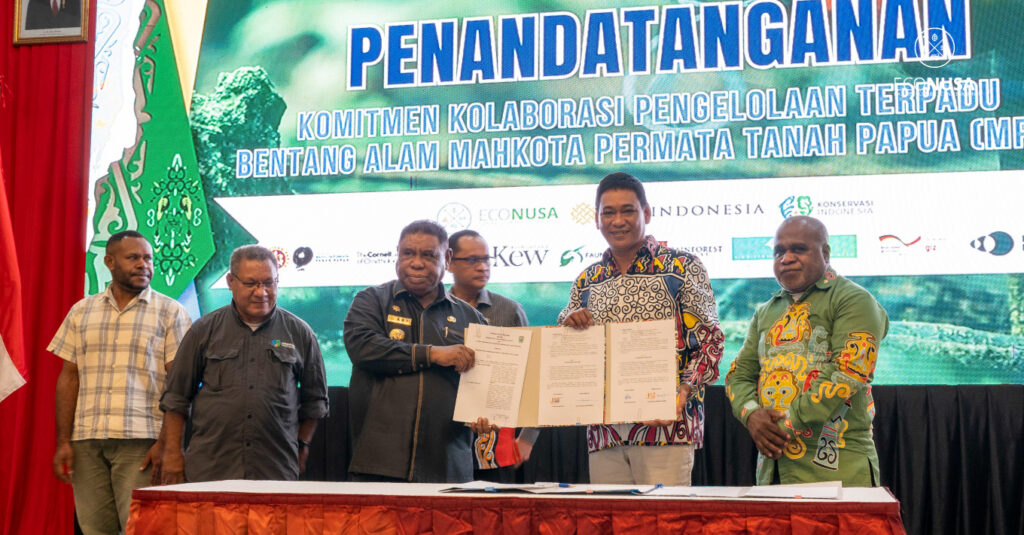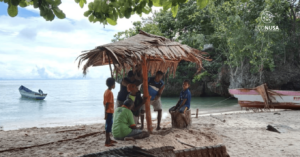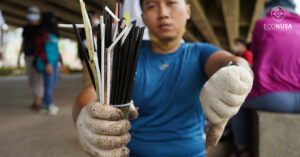
West Papua and Southwest Papua have a strategic area known as the Crown Jewel of Tanah Papua. This region encompasses the landscapes located in the bird’s head and neck of Papua, functioning as a vital area for conservation, biodiversity, and culture that supports sustainable development initiatives.
To develop this area, the provincial governments of West Papua and Southwest Papua launched the Mahkota Permata Tanah Papua (MPTP) Integrated Landscape Management Program, or the Crown Jewel of Tanah Papua (CJoP), on July 18, 2024. The Head of the West Papua Provincial Agency for Research and Regional Innovation (BRIDA), Charlie Heatubun, stated that the integrated landscape management initiative of MPTP reflects the commitment of the West Papua and Southwest Papua provincial governments to preserving biodiversity, cultural heritage, and managing natural resources in the Bird’s Head region of Tanah Papua.
“As a province committed to sustainable development with ecology-based performance, the West Papua Provincial Government is committed to maintaining 70 percent forest cover. This program is part of that commitment. The active involvement of the Southwest Papua Provincial Government also provides strong support for the management of the MPTP landscape,” he said.
Read Also: 7 Indigenous Territory Recognition Decrees Handed to 7 Clans in Klafyo and Waimon
Charlie mentioned that the program aims to ensure the protection of forests while recognizing indigenous peoples’ rights in managing their natural resources. It also supports the Central Government’s policies on climate change mitigation and biodiversity loss as outlined in the Folu Net Sink 2030 initiative.
Through this program, the governments of West Papua and Southwest Papua also collaborate with local governments within the region, as well as development partners under the MPTP consortium, including the EcoNusa Foundation and other non-governmental organizations.
According to Charlie, development partners within the MPTP consortium have previously worked in other areas. “EcoNusa, along with several local partners, is implementing programs to improve the welfare of local communities, enhance understanding of forest resource conservation, recognize indigenous rights through customary land mapping, and assist in exploring local commodity potentials,” he explained.
Therefore, he hopes that EcoNusa will play a significant role in enhancing the capacity and well-being of indigenous communities in the MPTP area. “And what is crucial is the regeneration process within the community, our relationship with local partners, and the younger generations, so that the vision and mission for managing the Crown Jewel of Tanah Papua landscape can be well understood and implemented,” he added.
Read Also: Victory! Indigenous Communities Secure Their Ancestral Lands
The CEO of the EcoNusa Foundation, Bustar Maitar, stated that in the coming years, EcoNusa will continue to support programs in this integrated area. “EcoNusa, for at least the next three years, will begin supporting programs to help indigenous peoples protect their rights and assist government efforts through mechanisms such as adat (customary) forests and social forestry, ensuring sustainable community economies and protecting this vital ecosystem,” he said.
The MPTP region is rich in biodiversity, serving as the main water source for rivers and cities surrounding the bird’s head and neck of Papua. The MPTP landscape also plays a crucial role in carbon storage, thus significantly contributing to climate change mitigation. Additionally, the area is home to several indigenous Papuan tribes, including the Abun, Hatam, Ireres, Kuri, Meyah, Miyah, Moile, Moskona, Mpur, Sough, Sough Bouhon, and Wamesa, making it a vital living space for their livelihoods.
Apart from the EcoNusa Foundation, the development partners in the MPTP consortium include Conservation International, WRI Indonesia, Yayasan Permata Tanah Papua, the University of Papua, the Royal Botanic Gardens Kew, WWF Indonesia, Bentara Papua, Fauna & Flora International, Cornell University Lab of Ornithology, the Rainforest Trust, Wedge Tail, GIZ-Forclime, and Yayasan Papua Nenda.
Reynold Kesaulija from the Forestry and Environment Agency of Southwest Papua hopes that the collaboration between the two provincial governments and the development partners will yield more tangible benefits for the environment and local communities. “Hopefully, we can protect and maintain the MPTP landscape while boosting the economic income and welfare of communities living in and around the area,” he said.




